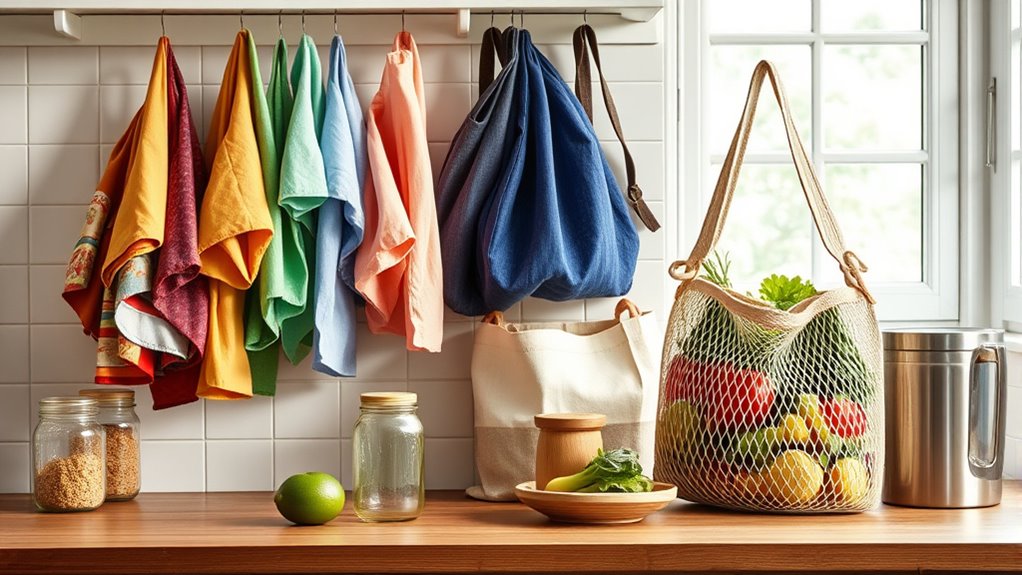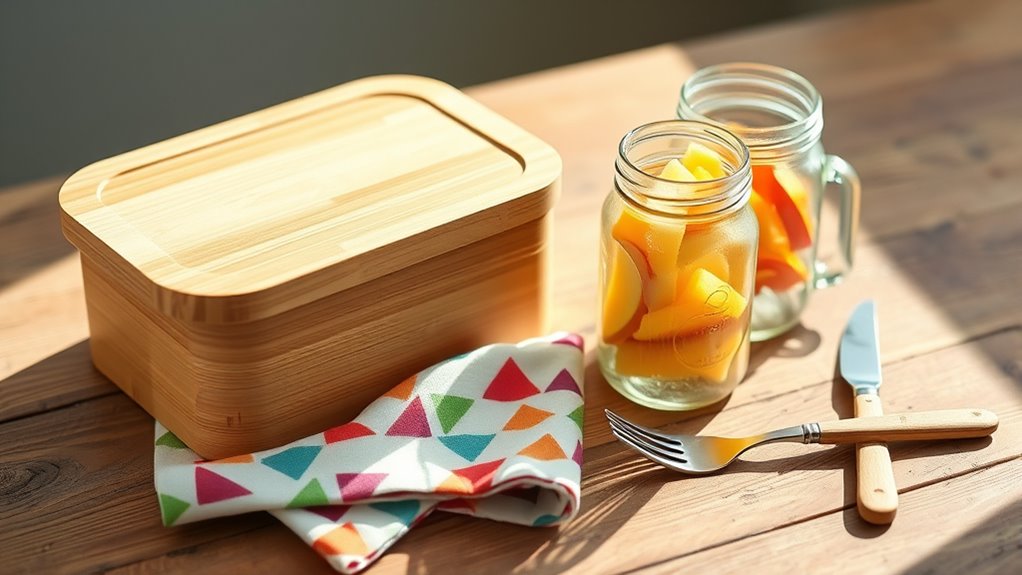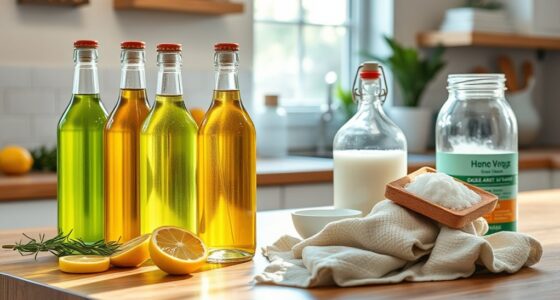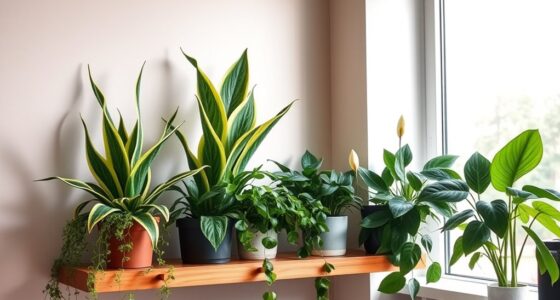You can replace plastic toothbrushes with bamboo ones, use reusable fabric or mesh bags instead of disposable plastic ones, switch out single-use water bottles for durable reusable containers, and opt for washable cloth towels over paper towels. Upgrade to safety razors, choose reusable lunch boxes, swap plastic wrap for beeswax or washable wraps, and switch to refillable laundry detergent sheets. If you keep exploring, you’ll discover even more sustainable swaps to create a greener lifestyle.
Key Takeaways
- Swap plastic water bottles for personalized, durable reusable bottles made from stainless steel or BPA-free plastics.
- Replace disposable plastic wrap with beeswax wraps or washable, natural fabric covers for food storage.
- Use upcycled or recycled containers, such as stainless steel lunch boxes or jars made from repurposed materials.
- Switch disposable razors and plastic straws with metal safety razors and reusable silicone, glass, or metal straws.
- Opt for reusable feminine care products like menstrual cups and cloth pads made from eco-friendly, biodegradable fabrics.
Replace Plastic Toothbrushes With Bamboo Alternatives

Switching from plastic toothbrushes to bamboo alternatives is a simple yet impactful way to reduce environmental waste. Bamboo toothbrushes are biodegradable and compostable, helping cut down the plastic waste piling up in landfills. Made from sustainably harvested bamboo, a fast-growing renewable resource, they support sustainable living practices. Bamboo handles are naturally antibacterial, supporting your oral hygiene without needing synthetic chemicals. By making this switch, you can save hundreds of millions of plastic brushes from polluting oceans each year. Most bamboo toothbrushes feature nylon bristles, which can be recycled or replaced, extending their eco-friendly benefits. Choosing bamboo over plastic aligns with your goal of living more sustainably while actively reducing the harmful impact of plastic waste on the planet. Incorporating eco-friendly materials into daily routines can further enhance your efforts to minimize environmental footprints. Additionally, biodegradable alternatives are increasingly available, making it easier to adopt sustainable habits. Embracing sustainable living practices can help protect natural resources and promote a healthier planet for future generations. Understanding the importance of recyclable materials and proper disposal methods can maximize the environmental benefits of bamboo products. Recognizing the importance of AI security and ongoing safety measures can also inspire more innovative approaches to sustainable and responsible living.
Swap Disposable Plastic Bags for Reusable Fabric or Mesh Bags

Switching to reusable fabric or mesh bags is a simple way to cut down on plastic waste and support eco-friendly materials. These bags are versatile, durable, and cost-effective since they last for years and can be washed easily. By choosing them, you also help reduce ocean pollution and wildlife harm, making a positive impact with every trip to the store. Additionally, using reusable eye patches can be an eco-friendly alternative to disposable skincare products, promoting sustainability in your beauty routine. Selecting water-efficient fixtures for your bathroom can further enhance your eco-conscious lifestyle by conserving water and reducing utility bills. Incorporating environmentally conscious habits, such as mindful shopping, can amplify your efforts to minimize waste and live sustainably. Understanding the science of sound healing can also inspire eco-friendly wellness practices that support mental health and overall well-being.
Eco-Friendly Material Choices
Have you considered replacing single-use plastic bags with reusable fabric or mesh alternatives? These sustainable options markedly cut down plastic waste, reducing it by up to 90% during grocery shopping. Made from eco-friendly materials like organic cotton or recycled polyester, reusable bags are durable, washable, and biodegradable. By choosing these alternatives, you can eliminate approximately 500 plastic bags per person each year. Mesh bags are especially practical—they allow proper airflow and visibility, keeping produce fresh longer. Switching to eco-friendly fabric or mesh bags not only supports waste reduction efforts but also lessens your reliance on non-recyclable plastic packaging. Embracing these sustainable materials helps protect the environment while making your shopping routine more eco-conscious and responsible. Additionally, selecting appropriate tire pressure for your gravel bike can improve riding comfort and efficiency on diverse terrains.
Versatile Usage Options
Using reusable fabric or mesh bags offers versatile ways to reduce plastic waste during your shopping trips. These eco-friendly alternatives can replace single-use plastic produce bags, cutting waste by up to 90%. Besides grocery shopping, you can repurpose them for DIY projects or as storage containers around your home. Their durability means you’ll save money and resources over time. Incorporating sustainable practices like this can significantly lower your environmental impact. Additionally, choosing upcycled materials for everyday items supports a rustic farmhouse aesthetic that emphasizes natural textures and eco-consciousness. By selecting items made from recycled fabrics, you can further enhance the sustainability of your lifestyle. Embracing upcycled alternatives encourages a circular economy, where materials are reused and repurposed to minimize waste. Engaging in upcycling efforts not only benefits the environment but also fosters creativity and resourcefulness in daily living.
Cost-Effective and Durable
Opting for reusable fabric or mesh bags instead of disposable plastic ones proves to be a smart, cost-effective choice that pays off over time. Reusable bags last for years, helping you save money by reducing the need for single-use plastic bags. Made from natural or recycled materials, they also lower your environmental impact. Mesh produce bags are lightweight, breathable, and dishwasher safe, making them perfect for fruits and vegetables. Many durable fabric bags feature reinforced seams and sturdy handles, so they withstand frequent use without tearing. By switching to these eco-friendly options, you can cut down on plastic waste by up to 80% annually per household. Incorporating reusable bags into your DIY home routines is a simple way to save money while making a positive environmental difference. Additionally, choosing sustainable materials for your bags supports responsible resource management and reduces deforestation concerns. Using reusable storage options can further reduce your reliance on disposable containers and packaging. Employing eco-friendly home products can enhance your efforts to minimize waste and promote sustainability. Implementing modern architectural techniques in your home storage solutions can further optimize space and functionality, aligning with sustainable design principles. Utilizing vertical storage solutions can further maximize space and keep your storage areas organized.
Switch Out Single-Use Water Bottles for Durable Reusable Containers

Why settle for single-use water bottles that quickly contribute to landfill waste when you can switch to durable, reusable containers? Reusable water bottles made of glass, stainless steel, or BPA-free plastic last for years, cutting down on the millions of plastic bottles discarded daily. By choosing a reusable water bottle, you reduce the roughly 1,500 plastic bottles consumed each second globally, helping to lower plastic pollution. Many feature insulation that keeps drinks hot or cold for 12-24 hours, offering better temperature control than disposable bottles. Plus, reusable bottles can be personalized with designs or logos, encouraging consistent use. Investing in a quality reusable water bottle not only supports your zero-waste lifestyle but also saves money over time, making it a practical and eco-friendly switch.
Use Reusable Cloth Towels Instead of Disposable Paper Towels

Switching from disposable water bottles to reusable containers is a great step toward reducing plastic waste, and replacing paper towels with cloth alternatives takes that effort even further. Reusable cloth towels can be washed and used hundreds of times, drastically cutting down household waste. Made from eco-friendly fabrics like organic cotton or hemp, they’re biodegradable and sustainable. Using cloth towels for cleaning and drying can reduce your paper towel consumption by up to 80%. These towels are highly absorbent, durable, and customizable to match your home decor. Switching to reusable cloth towels not only saves money but also prevents millions of tons of paper waste from ending up in landfills each year. It’s a simple, effective way to make your household more eco-friendly.
Upgrade to Reusable Safety Razors in Place of Plastic Disposable Razors

Upgrading to a reusable safety razor is a simple yet impactful way to reduce plastic waste in your daily routine. Made from durable metals like stainless steel or brass, reusable safety razors last a lifetime with proper care. Instead of constantly discarding plastic cartridges, you only need to replace the metal blades, which last up to 10 shaves or more, cutting down on single-use plastic. This switch can reduce your plastic waste by up to 90%, supporting a zero waste lifestyle. Over time, safety razors are more cost-effective since initial costs are around $20-$50, with blades costing approximately $0.10 each. By choosing a safety razor, you help minimize landfill waste and microplastic pollution, making your grooming routine more sustainable and eco-friendly.
Replace Plastic Straws With Metal, Glass, or Silicone Reusable Straws

Replacing disposable plastic straws with reusable metal, glass, or silicone alternatives is an effective way to cut down on plastic waste and protect our oceans. A reusable straw can last for years, drastically reducing the millions of single-use plastic straws discarded daily. Silicone straws are collapsible and portable, perfect for on-the-go use, while glass options offer a non-toxic, chemical-free alternative that’s easy to clean in dishwashers. By switching, you help prevent over 200 million plastic straws from polluting marine environments each day. Many reusable straw sets include cleaning brushes and cases, ensuring proper sanitation and longevity. Making this change not only reduces waste but also minimizes reliance on plastic packaging, supporting a more sustainable lifestyle and healthier oceans.
Opt for Reusable Lunch Boxes Instead of Single-Use Plastic Food Containers

Opting for reusable lunch boxes made of stainless steel or silicone is a simple yet impactful way to cut down on plastic waste. These durable options last for years, preventing the need for hundreds of single-use containers that often end up in landfills. Switching to reusable lunch boxes helps you avoid using plastic wrap and single-use containers daily, reducing your environmental footprint. Unlike disposable plastic food containers, these options are microwave-safe and easy to clean, supporting healthier eating habits. Over time, replacing single-use containers with reusable alternatives can eliminate the environmental impact of manufacturing and disposing of over 1,000 plastic containers per decade. Plus, you can save your family up to $200 annually on packaging costs, making this switch both eco-friendly and economical.
Use Washable Food Wraps or Beeswax Wraps Instead of Plastic Wrap

Switching to washable or beeswax wraps can substantially cut down your plastic waste and keep food fresh naturally. These wraps are easy to upcycle, requiring simple cleaning and maintenance to last up to a year. By choosing them, you not only reduce environmental impact but also enjoy a practical, reusable alternative.
Benefits of Beeswax Wraps
Beeswax wraps offer a natural and sustainable alternative to plastic wrap, providing a breathable, reusable seal for your food. Unlike plastic wrap, beeswax wraps can last up to a year with proper care, helping you cut down on single-use waste. They’re made from cotton infused with beeswax, jojoba oil, and tree resin, creating a natural, antimicrobial barrier that keeps food fresh without chemicals. Using washable beeswax wraps prevents microplastics and toxic chemicals released by plastic wrap, making them healthier for you and the environment. Plus, they’re versatile—you can shape them around bowls, sandwiches, or cheese. By switching to beeswax wraps, you not only extend the life of your food but also contribute to reducing plastic consumption and waste in your household.
Easy Upcycling Techniques
Using beeswax wraps is a simple and effective way to upcycle your food storage habits. These wraps are a perfect example of easy upcycling techniques that reduce reliance on single-use plastic. Made by infusing cotton fabric with beeswax, resin, and jojoba oil, they’re reusable and eco-friendly. To use, just mold the wrap around food or containers with your hands—body heat activates the beeswax to create a seal. When stored properly in a cool, dry place, beeswax wraps can last up to a year, making them a sustainable alternative. After use, wash them with cool water and mild soap, then air dry. This simple switch is a practical way to upcycle everyday items and minimize waste.
Storage and Maintenance Tips
To keep your washable beeswax wraps in top condition, proper storage and maintenance are essential. Beeswax wraps are a great upcycled alternative to plastic wrap, but they need specific storage tips to last. After use, gently wash beeswax wraps with cool water and mild soap, avoiding hot water or high heat, which can melt the wax. Air dry them completely before storing. When not in use, keep your beeswax wraps in a cool, dry place away from direct sunlight to preserve their pliability and adhesive qualities. Proper maintenance can help them be reused for up to a year, reducing waste. Following these storage tips ensures your beeswax wraps stay effective, making them a reliable, eco-friendly alternative for food storage.
Switch to Refillable Laundry Detergent Sheets or Concentrates

Switching to refillable laundry detergent sheets or concentrates is a simple way to cut down on plastic waste and make your laundry routine more eco-friendly. Refillable detergent sheets are lightweight, compact, and designed to reduce packaging compared to traditional liquid detergents, which often come in single-use bottles. These sheets usually contain plant-based, biodegradable ingredients, supporting a greener lifestyle. One sheet typically replaces a full load of laundry, decreasing transportation emissions and packaging waste. Many refillable options come in durable, reusable containers, further reducing the need for single-use plastic bottles and caps. By making this switch, you can cut household plastic waste by up to 95%, and you’ll also save space in your laundry area. It’s an easy, impactful upgrade for a more sustainable routine.
Transition to Reusable Feminine Care Products Like Menstrual Cups or Cloth Pads

Switching to menstrual cups or cloth pads lets you choose eco-friendly, natural fabrics that are gentle on your skin and the planet. These options are cost-effective, saving you hundreds over time while reducing waste sent to landfills and oceans. Making the switch supports healthier personal care and a more sustainable lifestyle.
Eco-Friendly Material Choices
Opting for reusable feminine care products made from eco-friendly materials offers a powerful way to reduce your environmental impact. These sustainable materials—such as medical-grade silicone, organic cotton, bamboo, or hemp—are natural, breathable, and biodegradable. When you choose products made from these options, you’re supporting a cleaner planet by avoiding plastics, synthetic fibers, and chemicals found in disposables. Picture:
- Soft, flexible menstrual cups fitting comfortably
- Gentle, breathable cloth pads made from organic cotton
- Natural fibers that reduce skin irritation
- Long-lasting items that can be reused for years
- Biodegradable materials breaking down harmlessly in the environment
Cost-Effective Personal Care
Choosing reusable feminine care products like menstrual cups and cloth pads not only benefits the environment but also saves you money over time. Reusable menstrual cups can last up to 10 years, drastically reducing waste compared to single-use pads and tampons that generate about 300 pounds of trash per person in a lifetime. Cloth pads, made from natural fabrics like cotton or bamboo, can be reused for years, minimizing landfill contributions. Switching to these options can save you between $200 and $300 annually on disposable products, making them a cost-effective choice for personal care.
| Product Type | Cost Savings (Annual) | Environmental Impact |
|---|---|---|
| Reusable menstrual cups | $200–$300 | Reduces packaging, manufacturing waste |
| Cloth pads | $200–$300 | Decreases landfill contributions |
| Proper maintenance | Minimal expense | Less chemical waste |
Frequently Asked Questions
What Are the Best Items to Upcycle?
When considering what to upcycle, focus on items you already have around. Glass jars and bottles are perfect for storage or decor, while old clothing can become practical tote bags or cleaning cloths. Cans and tins make great planters, and wooden pallets or ladders can be transformed into furniture or shelves. Even paper products like newspapers or egg cartons can serve in craft projects or organic gardening, reducing waste and giving items a new purpose.
How Do You Upcycle Everyday Items?
Did you know that upcycling can reduce waste by up to 70%? To upcycle everyday items, start by identifying objects you no longer need, like jars or old clothes. Get creative—turn jars into storage or decor, and transform clothing into bags or quilts. Paint cans or bottles for planters or art projects. Use household scraps for crafts or organization. Upcycling not only saves money but also helps protect the environment.
What Materials Can You Upcycle?
You can upcycle a variety of materials like glass bottles, jars, cans, fabric scraps, and cardboard boxes into new, useful items. Plastic containers and bottles become planters or storage, while natural materials like citrus peels and coffee grounds can be repurposed for cleaning or gardening. Old textiles turn into tote bags or cleaning cloths, and wine corks, paper, and tin cans are perfect for home decor and organization projects.
What Are Upcycled Products?
Think of upcycled products as modern-day alchemy, turning what’s old into something new and valuable. You create these by repurposing materials or objects into functional or decorative items, like turning jars into lanterns or textiles into art. You add creativity and care, reducing waste and extending resources. These products showcase innovation, making everyday items eco-friendly and stylish, all while helping the planet stay vibrant and alive.
Conclusion
Did you know that replacing just a few everyday items with upcycled alternatives can save hundreds of plastic bottles and packaging waste each year? By making small swaps—like using bamboo toothbrushes and reusable bags—you not only cut down on environmental impact but also inspire others to do the same. Every choice counts, and together, we can make a big difference. Start today, and watch how simple changes lead to a more sustainable future.









